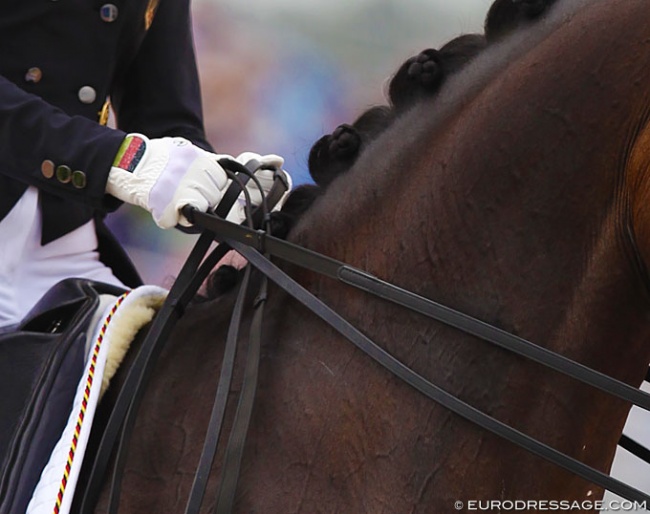
I have often wondered how much weight riders should have in the reins to account for both the comfort of the horse and the engagement of the hindquarters. How do we allow the horse to move freely and comfortably while still maintaining a steady contact?
I used to watch Nuno Oliveira when I was little and wondered how he was able to have the horse straight balanced and engaged with the reins in loops. Classical trainer Miguel Távora was once asked how Nuno did this and his reply was “he was a genius”.
Most riders today, I would say 99.9% of them, would not be able to establish this sort of brilliance, so we must search for an elastic feel on the horse’s mouth that doesn’t hold, nor drop the horse. It is the tightrope of dressage and we will search for it always on every horse.
“The amount of weight in the rein varies between horse-rider combinations,” said Dr Hilary Clayton, biomechanics expert.
After extensive studies into rein tension and stress response in dressage combinations Hilary has found that rein tension is not constant during the stride, as the amount of tension changes in a consistent pattern in each gait.
“In trot there is an increase in tension during each diagonal stance phase, in canter there is one increase per stride when the diagonal limb pair are grounded,” said Hilary. “If we take trot as an example and measure rein tension with side reins rather than a rider to get an idea of how much tension a horse likes to have, then there is a baseline tension of around half a kg and this increases to 2-4 kg during each diagonal stance phase.”
Hilary noted that this is the amount of contact a horse chooses to take with side reins, with no rider on board. “When ridden by a good rider, the tensions are about the same. There is a baseline tension of around half a kg and this is what the rider perceives as a fairly light contact,” she added.
So 500 grams in each hand that will increase naturally to around 2-4kgs with the movement of the horse.
I wondered then if the rider rides with too little contact, can the horse really be engaged?
“Good question,” Hilary replied. “The amount of tension necessary for effective communication between rider and horse likely decreases as the horse becomes better trained. I think of loose reins as being like driving a car that has a lot of play in the steering wheel. When you need to turn, you have to move the wheel until it reaches the place where it starts to turn the wheels and then it starts the turn with a bit of a jerk. With the reins,, if the rider keeps a little feel on the reins then the horse can respond immediately to the smallest change in tension. If the reins are loose, the rider has to establish a contact before the reins can be used for communication."
So keeping the elastic contact constant makes it easier to establish very subtle rein aids, and thus the rider won’t disrupt the balance of the horse!
“With regard to the question about engagement with loose reins, if the horse is ridden totally from the seat we can dispense with reins but for most of us that is only in our dreams,” said Clayton.
So, in theory you can engage the horse entirely with the seat, but for most of us that isn’t a reality. The best we can do is try to establish a very even and elastic contact, of about 500grams in each hand.
To ensure maximum elasticity, and given that as the horse moves the tension comes and goes, studies have shown that riders should ride with elastic reins, meaning reins that are themselves elastic! The studies conducted showed that a rider who rides with shorter reins puts considerably more tension on the horses mouth with inelastic reins because of course elastic reins naturally stretch when tension increases, which relieves some of the tensile force.
In summary , unless you are Nuno Oliveira or someone equally as gifted, we should aim for a constant, light, 500gram average contact; we should use reins made from elastic materials, and we should establish a seat that is balanced and effective enough to engage the horse , so that the reins merely act to soften and direct the horse without disturbing the balance or causing unnecessary tension in his mouth!
by Sarah Warne
Related Links
Rein Tension with Bitless Bridles Compared to Single-Jointed Snaffle Bits
The Effect of Martingale Attachments on Rein Tension in the Ridden Horse
Classical Training: This is not Lightness
Classical Training: Tools to Get Control